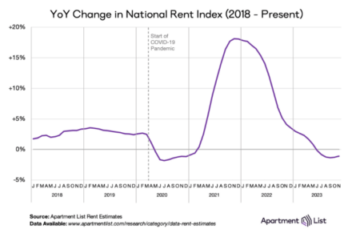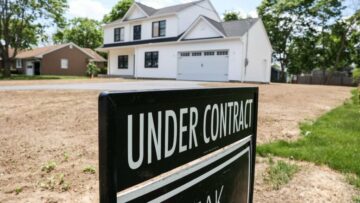Realtor.com’s latest monthly report reveals a market full of contradictions as mortgage rates continue to drive consumer sentiment and activity.
In these times, double down — on your skills, on your knowledge, on you. Join us Aug. 8-10 at Inman Connect Las Vegas to lean into the shift and learn from the best. Get your ticket now for the best price.
Homebuyer demand is slowly reemerging in time for spring, according to Realtor.com’s March Housing Report released on Thursday.
The portal’s listing data revealed a 27 percent decrease in median days on market from January to March, signaling that buyers are more willing to face market headwinds to seize a dip in mortgage rates.

Danielle Hale
“Signs show that buyers are active in the spring housing market, even if they aren’t as numerous as they were during the pandemic,” Realtor.com Chief Economist Danielle Hale said in a statement. “Amid fewer new choices on the market and still rising home prices, home shoppers have shown that they are very rate sensitive, only jumping back in the market when rates dip, and so what happens with rates this spring will likely play a strong role in determining whether the housing market bumps along or picks up speed this year.”
Although the number of active listings increased 59.9 percent year over year in March, the housing market is still severely under-resourced compared to pre-pandemic spring homebuying seasons (-46.9 percent) as homesellers struggle to weigh the risks and benefits of losing historically low mortgage rates and slimmer profit margins.
“With so much built-up equity, home sellers are still faring well, but many are sitting on the sidelines,” Hale said.
The annual decline in new listings accelerated 4.9 percent month over month to 20.1 percent in March, a result of slowing median listing price growth (+6.3 percent YoY to $424K).
Homesellers in the Midwest had the best luck, with annual listing price gains outpacing the national average (+14.1 percent), especially in Memphis, Tennessee (+40.3 percent), Milwaukee (+26.3 percent), and Kansas City, Missouri (+17.7 percent).
Meanwhile, annual listing price reductions were most common across the South with homesellers in Austin, Texas (-8.4 percent), Las Vegas (-6.7 percent) and New Orleans (-5.1 percent) making the biggest price concessions.
“At this rate of slowing, list prices could decline relative to last year as early as this summer, following the recent national median sale price decline, which fell annually for the first time in 10 years last month,” the report notes.
Even with the rise in price reductions, homes are still taking longer to sell as homebuyers face the same mortgage-rate dilemma as homesellers.
In March, the typical home spent 54 days on market — 18 days longer than March 2022, but 15 days faster than the pre-pandemic average of 69 days. Across the 50 largest U.S. metros, time on market was lower than the national pace at 46 days (+16 days from 2022), with Raleigh, North Carolina (+42 days), Kansas City, Missouri (+37 days), and Austin, Texas (+37 days), experiencing the biggest slowdowns.
Although current market conditions aren’t the most ideal for buyers or sellers, Hale and Realtor.com Executive News Editor Clare Trapasso said spring still offers the best opportunity for consumers to make a deal.
“The usual seasonal pickup in buyer demand appears to be underway, one of several factors that make spring the best time to sell,” Hale said. “With an uncertain market ahead, it may be even more important for potential sellers to aim for this year’s seasonal sweet spot.”
Added Trapasso, “Well-priced, move-in ready homes with curb appeal in desirable areas are still receiving multiple offers and selling for over the asking price in many parts of the country. So this spring, it’s especially important for sellers to make their homes as attractive as possible to appeal to as many buyers as possible.”
“Homes that are priced too high, are in need of major repairs or aren’t presented professionally are often sitting on the market for longer and sometimes selling for under the initial asking price.”
- SEO Powered Content & PR Distribution. Get Amplified Today.
- Platoblockchain. Web3 Metaverse Intelligence. Knowledge Amplified. Access Here.
- Source: https://www.inman.com/2023/03/30/homebuyers-and-sellers-played-chicken-as-sales-slowed-in-march/
- :is
- $UP
- 1
- 10
- 2022
- 7
- 8
- 9
- a
- accelerated
- According
- across
- active
- activity
- ahead
- and
- annual
- Annually
- appeal
- ARE
- areas
- AS
- At
- attractive
- Aug
- austin
- average
- back
- BE
- benefits
- BEST
- Biggest
- buyers
- chief
- choices
- City
- COM
- Common
- compared
- conditions
- Connect
- consumer
- consumer sentiment
- Consumers
- continue
- could
- country
- Current
- Danielle
- data
- Days
- deal
- Decline
- decrease
- Demand
- determining
- Dip
- double
- down
- drive
- during
- Early
- Economist
- editor
- equity
- especially
- Even
- executive
- experiencing
- Face
- factors
- faster
- First
- first time
- following
- For
- For Consumers
- from
- full
- Gains
- Growth
- happens
- Have
- headwinds
- High
- Home
- Homes
- housing
- housing market
- HTTPS
- ideal
- important
- in
- increased
- initial
- IT
- January
- join
- Join us
- jpg
- Kansas
- Kansas City
- knowledge
- largest
- LAS
- Las Vegas
- Last
- Last Year
- latest
- LEARN
- likely
- List
- listing
- Listings
- longer
- losing
- Low
- luck
- major
- make
- Making
- many
- March
- margins
- Market
- market conditions
- Month
- monthly
- MONTHLY REPORT
- more
- Mortgage
- most
- multiple
- National
- Need
- New
- New Orleans
- news
- North
- north carolina
- Notes
- number
- numerous
- of
- Offers
- on
- ONE
- Opportunity
- Pace
- pandemic
- parts
- percent
- Picks
- Pickup
- plato
- Plato Data Intelligence
- PlatoData
- Play
- played
- possible
- potential
- presented
- price
- Prices
- professionally
- Profit
- raleigh
- Rate
- Rates
- ready
- realtor
- receiving
- recent
- released
- report
- result
- Revealed
- Reveals
- rising
- risks
- Role
- s
- Said
- sale
- sales
- same
- seasons
- Seize
- sell
- Sellers
- Selling
- sensitive
- sentiment
- several
- shift
- Shoppers
- show
- shown
- Sitting
- skills
- slowdowns
- Slowing
- Slowly
- So
- South
- speed
- spent
- Spot
- spring
- Statement
- Still
- strong
- Struggle
- summer
- sweet
- taking
- texas
- that
- The
- their
- These
- this year
- ticket
- time
- times
- to
- too
- typical
- u.s.
- Uncertain
- under
- Underway
- us
- VEGAS
- weigh
- WELL
- What
- whether
- which
- will
- willing
- with
- year
- years
- Your
- zephyrnet












